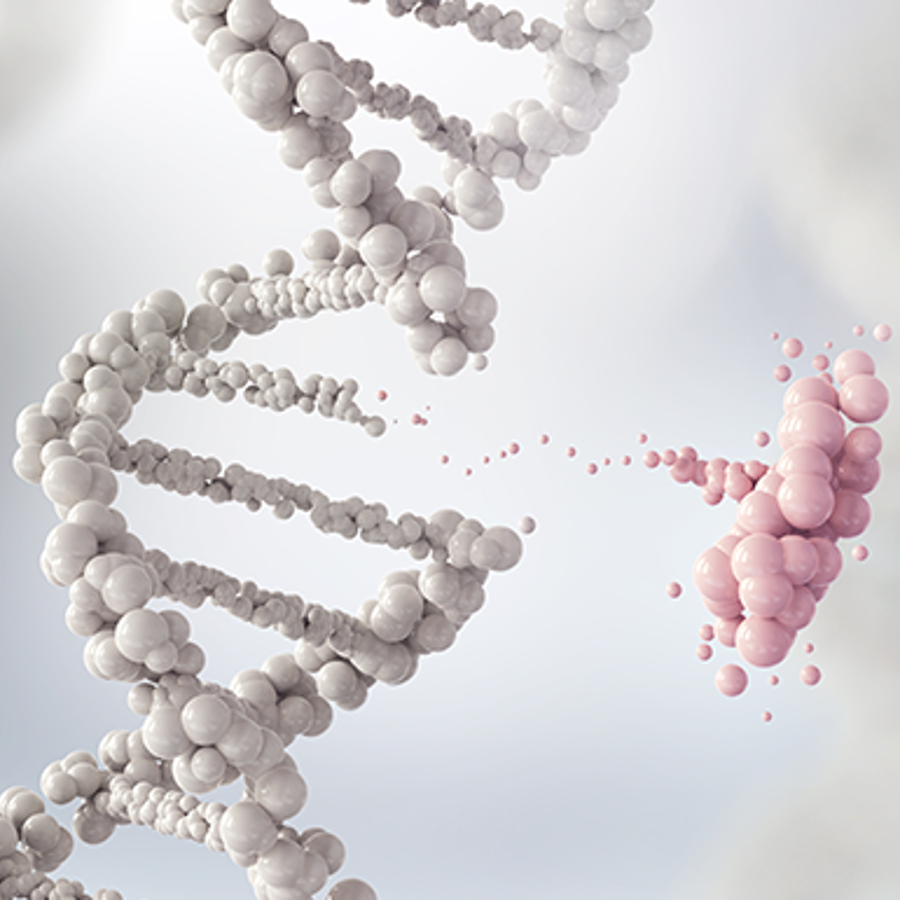
How do the origins of mutations relate to the spread of blue eyes?
February 3, 2006

- Related Topics:
- Eye color,
- Evolution,
- Pigmentation traits,
- Human evolution,
- Mutation
A curious adult from Michigan asks:
"Hi, I am curious about the origins of mutations, such as eye color, and how they relate to early mankind and the spread of that particular mutation. For example, I have very light eyes. Am I descended from a person who had this mutation, and subsequently passed on this mutation to all people with blue eyes living today? In other words, do I share a common blue-eyed ancestor with all people with blue eyes? Also, I’m curious about the origins of blue eyes. I’ve read that the mutation formed in northern latitudes as a result of less light. It seems to me that mutations occur randomly and not as a response to the environment."
Editor’s Note (Oct 2021): Since Kim wrote this answer, a new study came out that suggests that all blue eyed people came from a single ancestor. Click here to learn more.
This answer still has a great discussion about where mutations come from and how they can spread. Enjoy.
Great questions! The quick answers are: 1) blue eyes probably came from more than one ancestor, 2) mutations are random, and 3) blue-eyed people may have survived better in areas with less light because of our need for vitamins.
To understand how all of this fits together, let's first talk about what causes blue eyes. You get blue eyes if there is very little pigment in a certain part of your eye (the stroma of the iris).
Remember, genes are just instructions for making proteins like this pigment. If you have blue eyes, that means your genes tell your eyes not to make much pigment.

Eye Color Evolution
The first humans probably had brown eyes. To end up with blue eyes, at least two genes need to be changed. Not everyone with blue eyes has the same set of changes, though. This suggests that blue-eyed people do not all share one common blue-eyed ancestor.
But what caused blue eyes in the first place? And do blue eyes have anything to do with less light? We can answer the first question and make a couple of guesses about the second.
Blue eyes came about because of random changes in the genes that affect eye color. These changes are called mutations.
So, you are right that mutations occur randomly. There are two main reasons for mutations. First, some things in the environment can damage DNA, leading to mutations. This includes radiation from sunlight, which is why it is important to wear sunscreen.
Second, every time our cells divide to make new cells, they make another copy of all of their DNA to put into the new cell. You can imagine that it is hard to do this without ever making a mistake. Imagine trying to write a document with 6 billion letters perfectly!
Usually, our cells can catch these mistakes and fix them. This is sort of like using the delete key when you are typing. But once in a while, the repair machinery misses a mistake.
Some mutations don't have any effect or have effects that don't really matter. Other mutations are good; in fact, the only reason many adults can eat ice cream is because of a mutation causing lactose tolerance. And still other mutations can be really bad and cause disease or even death.
So blue eyes came about because a few different people got random mutations that happened to make them have blue eyes. Each of these random mutations was passed onto their kids and their kids' kids and so on. And today, there are many people that have at least one of these mutations causing blue eyes.
But even though mutations do form randomly, blue eyes were first seen in great numbers in Northern latitudes where there is less light. Is there a relationship? Maybe.

Possible Theories
One theory is that people with blue eyes also tend to have lighter skin (the same pigment that makes brown eyes also makes dark skin). In places with less sunlight, lighter skin can help the body make Vitamin D.
You need vitamin D to avoid bone diseases like rickets. In fact, lack of vitamin D used to be a big problem before refrigeration and vitamin D-fortified milk. So, lighter skin means you are less likely to get rickets.
Let's say you randomly get a mutation that gives you blue eyes and light skin. Now if you live in an area where there isn't much sunlight (Northern Europe, for example), you don’t need as much sunlight as your dark-skinned neighbors to avoid bone diseases.
Perhaps easily avoiding bone disease makes it easier for you to find a partner and have children. And some of these kids will have blue eyes and get sufficient sunlight as well. Eventually, you end up with lots of people with blue eyes.
Of course this is just an idea, and most people without blue eyes who live in dark places can live normal lives and can also have lots of kids too. Another theory is that blue eyes made it more difficult to survive in sunny places.
One idea is that light skin allows sunlight to destroy a vitamin called folate. You need folate to have healthy babies. If women don't get enough folate while they are pregnant, the baby can be born with birth defects. And if men don't get enough folate, they don't make as many sperm.
This would mean that people with blue eyes and light skin living in bright areas may have less healthy babies. So the genes for blue eyes would be less likely to get passed on in sunny places.
Or maybe both ideas came into play -- blue eyes in dark places provided more vitamin D, and brown eyes in bright places provided more folate. So, less light did not cause the mutations for blue eyes, but it might have made the mutations more likely to stick around.
Of course, it is also possible that it was just coincidence that blue eyes originated in northern latitudes. Perhaps there was simply no reason to not have blue eyes.
As we continue to learn more about the human genome, we will likely be able to better answer questions on the genetics of eye color and the evolution of blue eyes.

Author: Dr. Kim Matulef
When this answer was published in 2006, Kim was a post-doctoral fellow in the Department of Molecular and Cellular Physiology, studying chloride ion channels and transporters in Merritt Maduke's laboratory. Kim wrote this answer while participating in the Stanford at The Tech program.
 Skip Navigation
Skip Navigation
